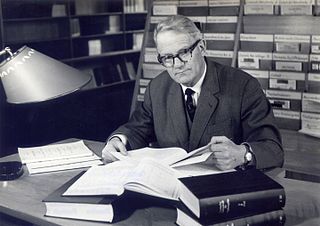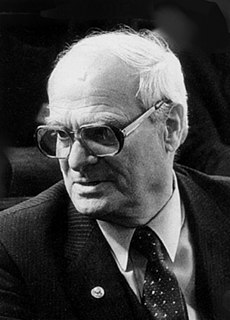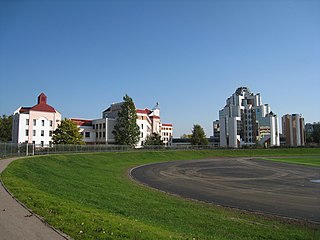
Zhores Ivanovich Alferov was a Soviet and Russian physicist and academic who contributed significantly to the creation of modern heterostructure physics and electronics. He shared the 2000 Nobel Prize in Physics for the development of the semiconductor heterojunction for optoelectronics. He also became a politician in his later life, serving in the lower house of the Russian parliament, the State Duma, as a member of the communist party since 1995.

George Gamow, born Georgiy Antonovich Gamov, was a Russian-born American polymath, theoretical physicist and cosmologist. He was an early advocate and developer of Lemaître's Big Bang theory. He discovered a theoretical explanation of alpha decay by quantum tunneling, invented the liquid drop model and the first mathematical model of the atomic nucleus, and worked on radioactive decay, star formation, stellar nucleosynthesis and Big Bang nucleosynthesis, and molecular genetics.

Igor Vasilyevich Kurchatov, was a Soviet nuclear physicist who is widely known as the director of the Soviet atomic bomb project. Along with Georgy Flyorov and Andrei Sakharov, Kurchatov is known as the "father of the Soviet atomic bomb" and later "the father of the Soviet nuclear missile" for his directorial role in a clandestine Soviet nuclear program formed during World War II in the wake of the Soviet discovery of the Western Allied efforts to develop nuclear weapons. After nine years of covert development, as well as Soviet spies successfully infiltrating the Manhattan Project, the Soviet Union successfully tested its first nuclear weapon, codenamed First Lightning, at the Semipalatinsk Test Range in 1949. In 1954 he was awarded the USSR State Prize in physics.

Moscow State University 'M. V. Lomonosov' is a public research university located in Moscow, Russia. It was founded in 1755 by Ivan Shuvalov and Mikhail Lomonosov, after whom it was renamed 'Lomonosov University' in 1940. Its rector is Viktor Sadovnichiy.

The Russian Academy of Sciences consists of the national academy of Russia; a network of scientific research institutes from across the Russian Federation; and additional scientific and social units such as libraries, publishing units, and hospitals.

The Institute for Theoretical and Experimental Physics is a multi-disciplinary research center located in Moscow, Russia. ITEP carries out research in the fields of theoretical and mathematical physics, astrophysics, high energy particle physics, nuclear physics, plasma physics, solid state physics, nanotechnology, reactor and accelerator physics, medical physics, and computer science. ITEP also maintains an extensive educational program and organizes physics schools for scholars and undergraduates. The institute is located near the corner of the Sevastopol prospect and the Nachimowski prospect and occupies part of the former estate "Cheryomushki-Znamenskoye" - an 18th-century manor that is a monument of architecture and landscape art of the 18th-19th centuries.

Abram Fedorovich Ioffe was a prominent Russian/Soviet physicist. He received the Stalin Prize (1942), the Lenin Prize (1960) (posthumously), and the Hero of Socialist Labor (1955). Ioffe was an expert in various areas of solid state physics and electromagnetism. He established research laboratories for radioactivity, superconductivity, and nuclear physics, many of which became independent institutes.

Yulii Borisovich Khariton was a Russian physicist and a leading scientist in the Soviet Union's nuclear weapons program. Since the initiation of the atomic bomb project by Joseph Stalin in 1943, Khariton was the "chief Nuclear weapon designer" and remained associated with the Soviet program for nearly four decades. In honour of the centennial of his birthday in 2004, his image appeared on a Russian postal stamp by the Russian government.

The Ioffe Physical-Technical Institute of the Russian Academy of Sciences is one of Russia's largest research centers specialized in physics and technology. The institute was established in 1918 in Petrograd and run for several decades by Abram Ioffe. The institute is a member of the Russian Academy of Sciences.
The Soviet atomic bomb project was the classified research and development program that was authorized by Joseph Stalin in the Soviet Union to develop nuclear weapons during World War II.

Anatoly Petrovich Alexandrov, also known as A.P. Alexandrov, was a Russian physicist who participated in Soviet Union's atomic bomb project. He was also the director of the Kurchatov Institute, academician and president of the Academy of Sciences of the Soviet Union (1975–1986).

Igor Mikhailovich Diakonoff was a Russian historian, linguist, and translator and a renowned expert on the Ancient Near East and its languages. His last name is occasionally spelled Diakonov. His brothers were also distinguished historians.

Peter the Great St. Petersburg Polytechnic University, abbreviated as SPbPU, is a Russian technical university located in Saint Petersburg. Other former names included Peter the Great Polytechnic Institute and Kalinin Polytechnic Institute. The university houses one of the country's most advanced research labs in hydro–aerodynamics. The university's alumni include Nobel Prize winners, such as Pyotr Kapitsa and Zhores Alferov, physicists and atomic weapon designers such as Yulii Khariton, Nikolay Dukhov, Abram Ioffe, Aleksandr Leipunskii, and Yakov Zeldovich, aircraft designers and aerospace engineers, such as Yulii Khariton, Oleg Antonov, Nikolai Polikarpov, and Georgy Beriev, and chess grandmasters, such as David Bronstein. The university offers academic programs at the Bachelor, Master's, and Doctorate degree levels. SPbSPU consists of structural units called Institutes divided into three categories: Engineering Institutes, Physical Institutes, and Economics and Humanities Institutes. In 2022, the university was ranked #301 in the world in the Times Higher Education (THE) World University Rankings, #393 in QS World University Rankings, #523 in Best Global Universities Rankings by U.S. News & World Report, and #1,005 by Center for World University Rankings.

Josef 'Sepp' Schintlmeister was an Austrian-German nuclear physicist and alpinist from Radstadt. During World War II, he worked on the German nuclear energy project, also known as the Uranium Club. After World War II, he was sent Russia to work on the Soviet atomic bomb project. After he returned to Vienna, he took positions in East Germany. He was a professor of physics at the Technische Hochschule Dresden as well holding a leading scientific position at the Rossendorf Central Institute for Nuclear Research.

Abram Isaakovich Alikhanov was a Soviet Armenian experimental physicist who specialized in particle and nuclear physics. He was one of the Soviet Union's leading physicists.

Mikhail Mikhaylovich Shultz, was a Soviet/Russian physical chemist, artist. Proceedings of the thermodynamic theory, the thermodynamics of heterogeneous systems, the theory of glasses, chemistry and electrochemistry of glass, membrane electrochemistry, the theory of ion exchange and phase equilibria of multicomponent systems, the theory of glass electrode. The name of the scientist linked the formation of pH-meters and ionometry, production organisation, instrumentation and materials commonly used in medicine, chemical and nuclear industry, aviation rocket and space technology, agriculture and many other areas.

Alferov Federal State Budgetary Institution of Higher Education and Science Saint Petersburg National Research Academic University of the Russian Academy of Sciences was founded in 1997 originally as the Research and Education Center of the Ioffe Institute to integrate science and education in the field of physics and information technologies. It has the distinction of being the only university in the Russian Academy of Sciences (RAS), which is composed primarily of national research institutes. Accordingly, the word "Academic" in the university's name stems from the Academy of Sciences, the organization that unites numerous national research institutes in Russia. The St. Petersburg Academic University was founded by Zhores Alferov, director of the Ioffe Institute, vice-president of the RAS Academician and Nobel prize laureate, who served as its rector until his death on March 1, 2019.

Konstantin Antonovich Petrzhak was a Russian nuclear physicist of Polish origin, and a professor of physics at the Saint Petersburg State University.
Gregory Evgenievich (Ezekielevich) Pikus was a prominent Soviet theoretical physicist whose contributions strongly influenced developing physics of semiconductors. Among his most fundamental contributions are development of the method of invariants in band theory of solids, the Bir-Aronov-Pikus mechanism of spin relaxation of electrons, prediction of the circular photogalvanic effect, and theory of weak localization in noncentrosymmetric structures. His three monographs reflect the focus points of the theory of semiconductors during the second half of 20th century from transistors to band theory to properties to artificial nanostructures.
Zinaida Vasilyevna Yershova was a Soviet and Russian chemist, physicist and engineer. She spent her entire career working with radioactive elements and headed laboratories producing radioactive materials used mostly in the Soviet atomic bomb project and the Soviet space program.

















